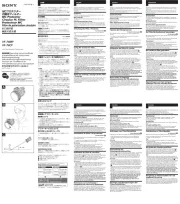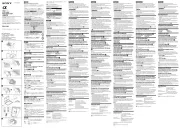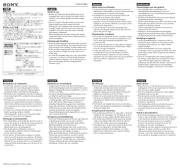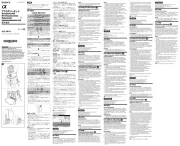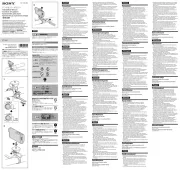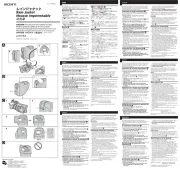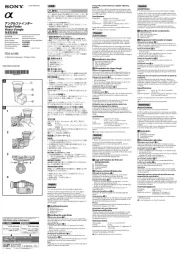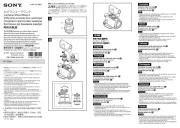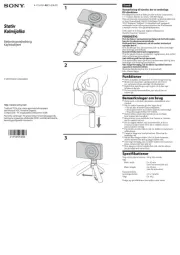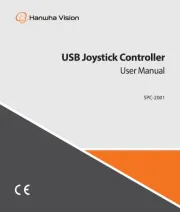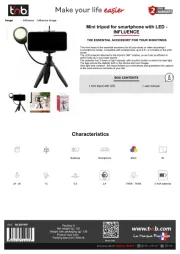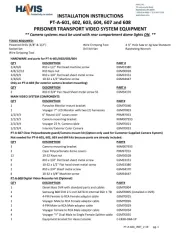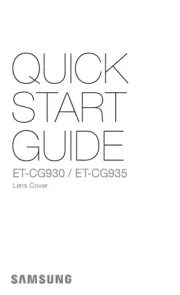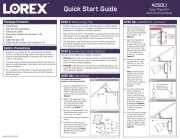Specications
Input rating 100 V - 240 V AC 50 Hz/60 Hz
4 VA - 7 VA 2 W
Output rating Battery charge terminal:
4.2 V DC 0.25 A
Operating temperature 0 °C to 40 °C
Storage temperature –20 °C to +60 °C
Dimensions (Approx.) 55 mm × 83 mm × 24 mm (w/h/d)
Mass Approx. 52 g
Design and specications are subject to change without notice.
e ACC-CSFG comes with the following accessories:
ACC-CSFG
Rechargeable Battery Pack (NP-FG1) (1)
Battery Charger (BC-CSGD) (1)
AC Power cord (mains lead) (1)
Set of printed documentation
NP-FG1
Specications
Maximum output voltage: DC 4.2 V / Mean output voltage: DC 3.6 V /
Capacity (typ.): 3.4 Wh (960 mAh) / Capacity (min.): 3.3 Wh (910 mAh)
/ Operating temperature: 0 °C to 40 °C / Dimensions: Approx. 35.5 mm ×
8.3 mm × 41.6 mm (w/h/d) / Mass: Approx. 27 g
e “InfoLITHIUM” is a lithium ion battery pack which can exchange
data with compatible electronic equipment about its energy consumption.
Sony recommends that you use the “InfoLITHIUM” battery pack with
electronic equipment having the logo.
Actual performance will vary based on product settings, usage patterns
and environmental conditions.
e indication may not be accurate depending on the condition and
environment which the equipment is used under.
and “InfoLITHIUM” are trademarks of Sony Corporation.
BC-CSGD
ank you for purchasing the Sony Battery charger.
Before operating this Battery charger, please read this manual thoroughly
and retain it for future reference.
WARNING
To reduce re or shock hazard, do not expose the unit to rain or moisture.
Do not expose the batteries to excessive heat such as sunshine, re or the
like.
To reduce the risk of re or electric shock,
1) do not expose the unit to rain or moisture.
2) do not place objects lled with liquids, such as vases, on the apparatus.
CAUTION
Use the nearby wall outlet (wall socket) when using this unit. ˎ
Even when the CHARGE lamp of this unit is o, the power is not
disconnected. If any trouble occurs while this unit is in use, unplug it
from the wall outlet (wall socket) to disconnect the power.
Do not use this unit in a narrow space such as between a wall and ˎ
furniture.
PRECAUTION
e set is not disconnected from the AC power source (mains) as long
as it is connected to the wall outlet (wall socket), even if the set itself has
been turned o.
NOTICE FOR THE CUSTOMERS IN THE UNITED KINGDOM
A moulded plug complying with BS 1363 is tted to this equipment for
your safety and convenience.
Should the fuse in the plug supplied need to be replaced, a fuse of the
same rating as the supplied one and approved by ASTA or BSI to BS 1362,
(i.e., marked with or mark) must be used.
If the plug supplied with this equipment has a detachable fuse cover, be
sure to attach the fuse cover aer you change the fuse. Never use the plug
without the fuse cover. If you should lose the fuse cover, please contact
your nearest Sony service station.
< Notice for the customers in the countries applying EU Directives >
e manufacturer of this product is Sony Corporation, 1-7-1 Konan
Minato-ku Tokyo, 108-0075 Japan. e Authorized Representative for
EMC and product safety is Sony Deutschland GmbH, Hedelnger Strasse
61, 70327 Stuttgart, Germany. For any service or guarantee matters please
refer to the addresses given in separate service or guarantee documents.
For Customers in Europe
Disposal of Old Electrical & Electronic Equipment
(Applicable in the European Union and other
European countries with separate collection
systems)
is symbol on the product or on its packaging indicates
that this product shall not be treated as household
waste. Instead it shall be handed over to the applicable
collection point for the recycling of electrical and
electronic equipment. By ensuring this product is disposed
of correctly, you will help prevent potential negative
consequences for the environment and human health,
which could otherwise be caused by inappropriate waste
handling of this product. e recycling of materials will
help to conserve natural resources. For more detailed
information about recycling of this product, please contact
your local Civic Oce, your household waste disposal
service or the shop where you purchased the product.
e nameplate indicating operating voltage, power consumption, etc. is ˎ
located on the bottom.
Notes on Use
This unit does not have dust-proof, splash-proof or water-proof
specications.
Warranty for Recorded Content
Contents of the recording cannot be compensated if recording or
playback is not made due to a malfunction of the battery pack, battery
charger, etc.
Where not to place this unit
Do not place this unit in any of the following locations, whether it is in
use or in storage. Doing so may lead to a malfunction.
In direct sunlight such as on dashboards or near heating apparatus, as ˎ
this unit may become deformed or malfunction
Where there is excessive vibration ˎ
Where there is strong electromagnetism or radiant rays ˎ
Where there is excessive sand ˎ
In locations such as the seashore and other sandy areas or where dust
clouds occur, protect this unit from sand and dust. ere is a risk of
malfunction.
Precautions on Use
Attach the battery pack rmly to this unit when charging the battery ˎ
pack.
To protect the battery pack, remove it from this unit when charging is ˎ
completed.
Do not drop or apply mechanical shock to this unit. ˎ
Keep this unit away from TVs or AM receivers. ˎ
Noise from this unit may enter a TV or radio if placed nearby.
Unplug this unit from the wall outlet (wall socket) aer use. To ˎ
disconnect the power cord (mains lead), pull it out by the plug. Never
pull the power cord (mains lead) itself.
Be sure that nothing metallic comes into contact with the metal parts of ˎ
this unit. If it does, a short may occur and this unit may be damaged.
Do not connect this unit to a voltage adaptor (travel converter) for ˎ
overseas travel. is may result in overheating or another malfunction.
e battery pack and this unit can become warm during or immediately ˎ
aer recharging.
Maintenance
If this unit gets dirty, wipe it using a so dry cloth. ˎ
If this unit gets very dirty, wipe it using a cloth with a little neutral ˎ
solvent added, and then wipe it dry.
Do not use thinners, benzine, alcohol, etc., as they will damage the ˎ
surface of this unit.
When you use a chemical cleaning cloth, refer to its instruction manual. ˎ
Using a volatile solvent such as an insecticide or keeping this unit ˎ
in contact with a rubber or vinyl product for a long time may cause
deterioration or damage to this unit.
To Charge the Battery Pack
1 Attach the battery pack.
Keeping the battery mark in the same direction as the charger mark
, insert the battery pack until it clicks into place. (See illustration
).
2 Connect the power cord (mains lead) to this unit and then
to a wall outlet (wall socket) (See Illustration ).
e CHARGE lamp (orange) lights up and charging begins.
When the CHARGE lamp goes out, normal charging is completed
( ).Normal charge
For a full charge, which allows you to use the battery pack longer than
usual, leave the battery pack in place for approximately another one
hour (Full charge).
e BC-CSGD battery charger can only be used to charge an ˎ
“InfoLITHIUM” battery pack (type G).
“InfoLITHIUM” battery packs (type G) have the ˎ mark.
is unit cannot be used to charge a nickel cadmium type or nickel ˎ
metal hydride type battery pack.
“InfoLITHIUM” is a trademark of Sony Corporation. ˎ
Le chargeur de batterie BC-CSGD ne peut être utilisé que pour ˎ
charger les batteries « InfoLITHIUM » (type G).
Les batteries « InfoLITHIUM » (type G) portent la marque ˎ.
Cet appareil ne peut pas être utilisé pour charger une batterie ˎ
rechargeable nickel-cadmium ou nickel-hydrure métallique.
« InfoLITHIUM » est une marque commerciale de Sony Corporation. ˎ
Battery
mark
Repère de
la batterie
AC input terminal
Borne d’entrée CA
Battery pack
Batterie
rechargeable
Charger mark
Repère du
chargeur
CHARGE lamp
Témoin
CHARGE
to wall outlet (wall socket)
À une prise murale
Power cord (Mains lead)
Cordon d’alimentation
L’ ACC-CSFG est livré avec les accessoires suivants :
ACC-CSFG
Batterie rechargeable (NP-FG1) (1)
Chargeur de batterie (BC-CSGD) (1)
Cordon d’alimentation secteur (1)
Jeu de documents imprimés
NP-FG1
Spécications
Tension de sortie maximale: 4,2 V CC / Tension de sortie moyenne: 3,6
V CC / Capacité (typ.): 3,4 Wh (960 mAh) / Capacité (min.): 3,3 Wh
(910 mAh) / Température de fonctionnement: 0 °C à 40 °C / Dimensions:
environ 35,5 mm × 8,3 mm × 41,6 mm (l/h/p) / Poids: environ 27 g
La batterie «InfoLITHIUM» est une batterie au lithium-ion qui peut
échanger des informations concernant son autonomie avec les appareils
électroniques compatibles. Sony vous conseille d’utiliser la batterie
« InfoLITHIUM » avec les appareils électroniques portant le logo
.
Les performances réelles varieront selon les réglages de l’appareil,
l’utilisation ou les conditions environnantes.
Suivant les conditions et l’environnement d’utilisation du matériel,
l’indication peut manquer de précision.
et «InfoLITHIUM» sont des marques de fabrique de Sony
Corporation.
BC-CSGD
Merci pour l’achat de ce chargeur de batterie Sony.
Avant d’utiliser ce chargeur de batterie, veuillez lire attentivement ce
manuel et le conserver pour toute référence future.
AVERTISSEMENT
An de réduire les risques d’incendie ou de décharge électrique, n’exposez
pas cet appareil à la pluie ou à l’humidité.
N’exposez pas les piles à une chaleur excessive, notamment aux rayons
directs du soleil, à une amme, etc.
Pour réduire les risques d’incendie ou d’électrocution,
1) n’exposez l’appareil à la pluie ou à l’humidité ;
2) ne placez pas d’objets remplis de liquides (vases, etc.) sur l’appareil.
ATTENTION
Utilisez une prise murale proche lorsque vous utilisez cet appareil. ˎ
Même lorsque le témoin CHARGE de cet appareil est éteint,
l’alimentation n’est pas coupée. Si un problème devait se produire
pendant l’utilisation de cet appareil, débranchez celui-ci de la prise
murale pour le mettre hors tension.
N’utilisez pas cet appareil dans un espace conné, comme entre un mur ˎ
et un meuble.
PRÉCAUTION
L’appareil n’est pas déconnecté de la source d’alimentation secteur tant
qu’il reste branché sur la prise murale, même s’il a été mis hors tension.
< Avis aux consommateurs des pays appliquant les Directives UE >
Le fabricant de ce produit est Sony Corporation, 1-7-1 Konan Minato-
ku Tokyo, 108-0075 Japon. Le représentant agréé pour la compatibilité
électromagnétique et la sécurité du produit est Sony Deutschland GmbH,
Hedelnger Strasse 61, 70327 Stuttgart, Allemagne. Pour toute question
relative à la garantie ou aux réparations, reportez-vous à ľadresse que
vous trouverez dans les documents ci-joints, relatifs à la garantie et aux
réparations.
Pour les clients en Europe
Traitement des appareils électriques et
électroniques en n de vie (Applicable dans les pays
de l’Union Européenne et aux autres pays européens
disposant de systèmes de collecte sélective)
Ce symbole, apposé sur le produit ou sur son emballage,
indique que ce produit ne doit pas être traité avec les
déchets ménagers. Il doit être remis à un point de collecte
approprié pour le recyclage des équipements électriques et
électroniques. En vous assurant que ce produit sont mis au
rebut de façon appropriée, vous participez activement à la
prévention des conséquences négatives que leur mauvais
traitement pourrait provoquer sur l’environnement et sur
la santé humaine. Le recyclage des matériaux contribue par
ailleurs à la préservation des ressources naturelles. Pour
toute information complémentaire au sujet du recyclage de
ce produit, vous pouvez contacter votre municipalité, votre
déchetterie locale ou le point de vente où vous avez acheté
le produit.
La plaque signalétique indiquant la tension de fonctionnement, la ˎ
consommation, etc. se trouve sous l’appareil.
Remarques concernant l’emploi
Cet appareil n’est pas étanche à la poussière, aux éclaboussures
d’eau ou à l’eau.
Garantie concernant les enregistrements
L’utilisateur ne pourra pas être dédommagé pour une absence
d’enregistrement ou de lecture due à une défectuosité de la batterie, du
chargeur de batterie, ou autre.
Où ne pas poser l’appareil
Ne posez pas cet appareil aux endroits suivants, ni pour la charge ni pour
l’entreposage. Ceci peut entraîner une panne.
À la lumière directe du soleil, comme sur le tableau de bord d’une ˎ
voiture ou à proximité d’un appareil de chauage, car l’appareil peut se
déformer ou tomber en panne.
À un endroit exposé à des vibrations excessives ˎ
À un endroit exposé à un électromagnétisme ou à des radiations ˎ
À un endroit où il y a beaucoup de sable ˎ
Au bord de la mer ou sur des sols sableux, où aux endroits où des
nuages de poussière sont fréquents, protégez l’appareil du sable ou de la
poussière. L’appareil risquerait sinon de tomber en panne.
Précautions d’emploi
Insérez bien la batterie rechargeable dans cet appareil avant de la ˎ
charger.
Pour protéger la batterie rechargeable, retirez-la de cet appareil lorsque ˎ
la charge est terminée.
Ne laissez pas tomber ou n’appliquez pas de choc mécanique à cet ˎ
appareil.
Gardez cet appareil à l’écart des téléviseurs ou récepteurs AM. ˎ
Placé près d’un téléviseur ou d’un poste de radio, cet appareil peut
causer du bruit.
Débranchez cet appareil de la prise murale après utilisation. Pour ˎ
débrancher le cordon d’alimentation, tirez sur la che. Ne tirez jamais
sur le cordon d’alimentation proprement dit.
Veillez à ne pas mettre d’objets métalliques au contact des pièces ˎ
métalliques de cet appareil. Ceci pourrait causer un court-circuit et
endommager l’appareil.
Ne branchez pas cet appareil sur un adaptateur de tension ˎ
(convertisseur de voyage) lorsque vous voyagez à l’étranger. Ceci
pourrait causer une surchaue ou une autre défaillance.
La batterie rechargeable et cet appareil peuvent devenir chauds pendant ˎ
ou immédiatement après la charge.
Entretien
Lorsque cet appareil est sale, essuyez-le avec un chion sec et doux. ˎ
Lorsque cet appareil est très sale, essuyez-le avec un chion et un peu ˎ
de solvant neutre puis séchez-le.
N’utilisez pas de diluants, benzine, alcool, etc. car ils endommageraient ˎ
la surface de cet appareil.
Si vous utilisez un tissu de nettoyage chimique, consultez son mode ˎ
d’emploi.
L’emploi d’un solvant volatil, comme un insecticide, ou la mise en ˎ
contact direct de cet appareil avec un produit en caoutchouc ou en
plastique pendant une longue période peut détériorer ou endommager
cet appareil.
Pour charger la batterie rechargeable
1 Insérez la batterie rechargeable.
Alignez le repère de la batterie dans la direction du repère du
chargeur et insérez la batterie de sorte qu’elle s’encliquette. (Voir
l’illustration ).
2 Raccordez le cordon d’alimentation à cet appareil puis à
une prise murale (Voir l’illustration ).
Le témoin CHARGE (orange) s’allume et la recharge commence.
Lorsque le témoin CHARGE s’éteint, la charge normale est terminée
( ).Charge normale
Pour une charge complète, qui permet d’utiliser la batterie
rechargeable plus longtemps que la normale, laissez la batterie
rechargeable en place pendant encore une heure environ (Charge
complète).
Pour retirer la batterie rechargeable
Retirez la batterie en la faisant glisser dans le sens opposé de l’insertion.
Temps de charge
Batterie rechargeable NP-FG1
Temps de charge normale
(environ) 270 min
Pour de plus amples informations sur l’autonomie d’une batterie, ˎ
reportez-vous au mode d’emploi de votre appareil photo.
Le temps de charge peut être diérent selon l’état de la batterie ˎ
rechargeable ou la température ambiante.
Les temps indiqués correspondent à la charge d’une batterie ˎ
rechargeable vide, usée sur cet appareil, à une température ambiante de
25 °C.
Température de charge
La température doit se situer entre 0 °C et 40 °C pour la charge. Pour
une ecacité maximale de la batterie, la température conseillée pour
la charge est de 10 °C à 30 °C.
Pour utiliser rapidement la batterie rechargeable
Vous pouvez retirer la batterie rechargeable de cet appareil et l’utiliser
même si la charge n’est pas terminée. Cependant, le temps de charge a une
inuence sur l’autonomie de la batterie rechargeable.
Remarques
Si le témoin CHARGE ne s’allume pas, vériez si la batterie ˎ
rechargeable est bien insérée dans cet appareil.
Lorsqu’une batterie chargée est installée, le témoin CHARGE s’allume ˎ
une fois puis s’éteint.
Une batterie rechargeable qui n’a pas été utilisée pendant longtemps ˎ
peut être plus longue à charger que la normale.
La batterie chargée se décharge graduellement même si elle n’est pas ˎ
utilisée. Chargez la batterie rechargeable pour éviter de manquer des
occasions d’enregistrer.
Cet appareil supporte les tensions du monde entier, de 100 V à 240 V.
N’utilisez pas un transformateur électronique de tension car ceci
pourrait provoquer un dysfonctionnement.
En cas de problème
Lorsque le témoin CHARGE clignote, vériez les points du tableau
suivant.
Le témoin CHARGE clignote de deux façons.
Clignotement lent : S’allume et s’éteint toutes les 1,5 secondes de façon
répétée.
Clignotement rapide : S’allume et s’éteint toutes les 0,15 secondes de façon
répétée.
La mesure à prendre dépend de la façon dont le témoin CHARGE
clignote.
Lorsque le témoin CHARGE continue de clignoter lentement
La charge est en pause. Cet appareil est en attente.
Si la température de la pièce est hors de la plage de températures
appropriée, la charge s’arrête automatiquement.
Lorsque la température de la pièce revient dans la plage appropriée, le
témoin CHARGE s’allume et la charge redémarre.
Il est conseillé de charger la batterie rechargeable entre 10 °C et 30 °C.
Lorsque le témoin CHARGE continue de clignoter rapidement
La première fois que vous chargez la batterie dans une des situations
suivantes, le témoin CHARGE peut clignoter rapidement.
Dans ce cas, retirez la batterie de cet appareil puis réinsérez-la et
chargez-la de nouveau.
Si la batterie est restée longtemps inutilisée
Si la batterie est restée longtemps dans l’appareil photo
Immédiatement après l’achat
Si le témoin CHARGE continue de clignoter rapidement, vériez les
points du tableau suivant.
